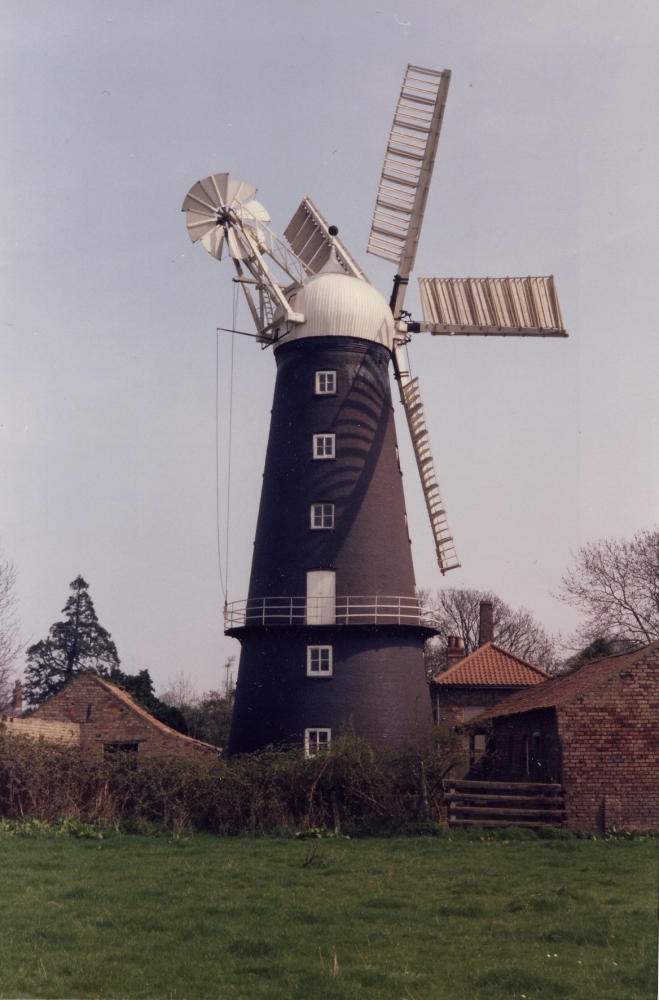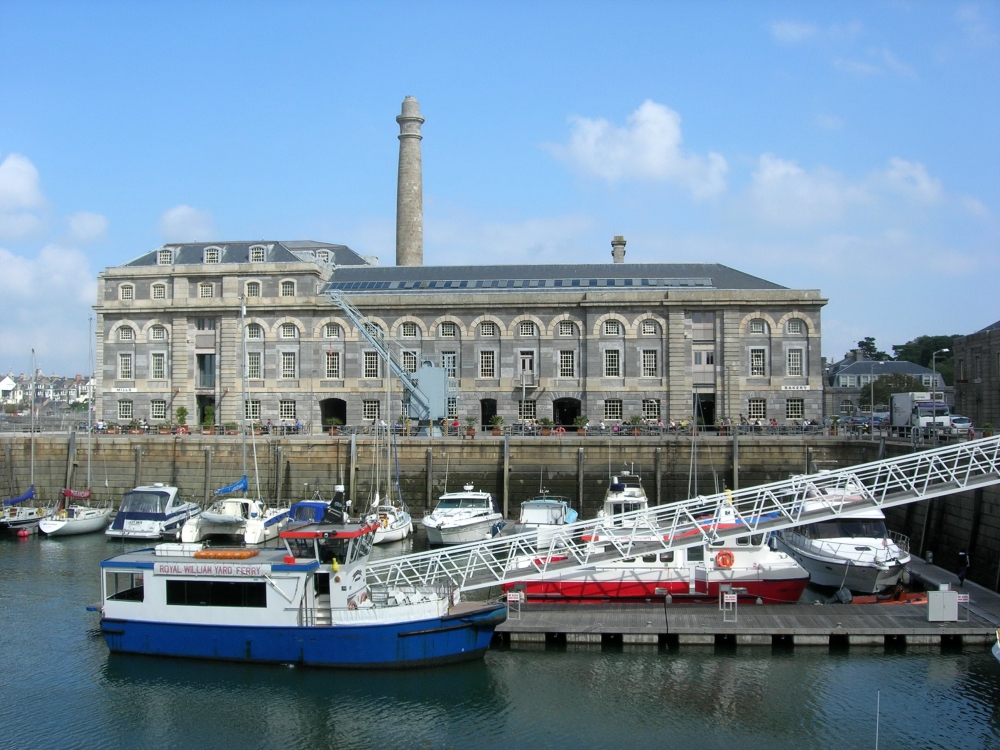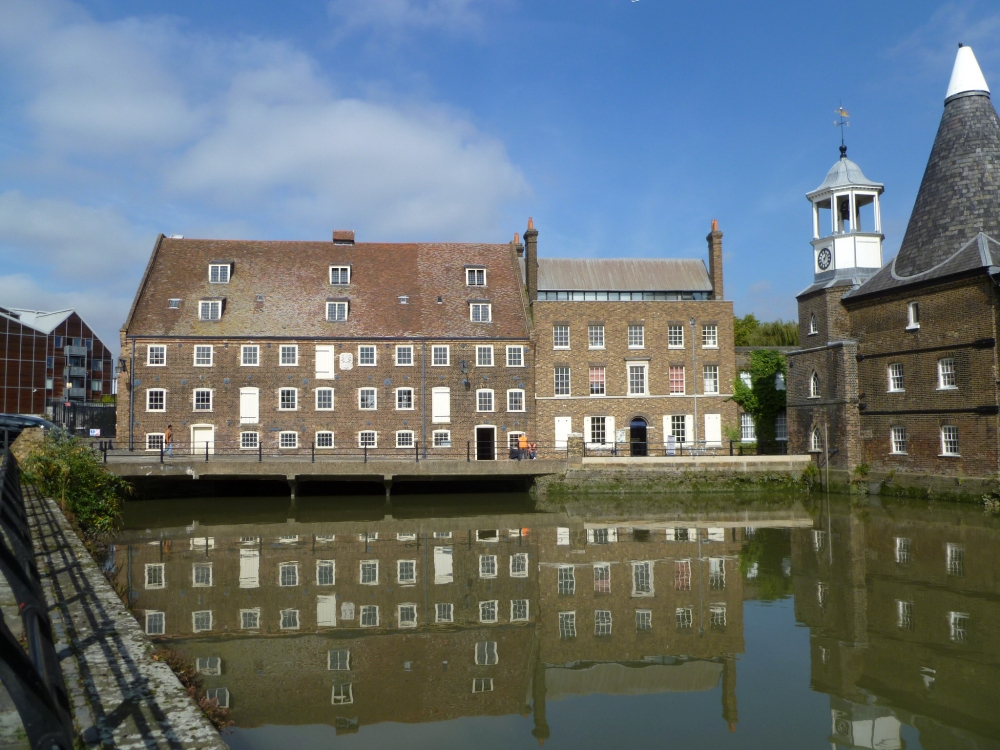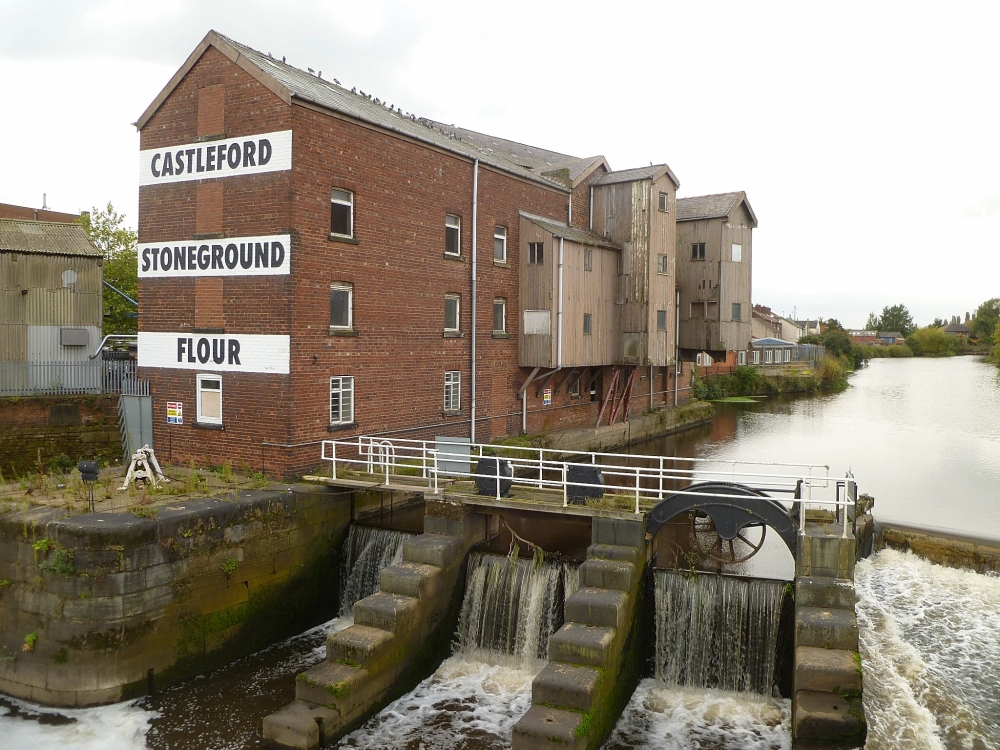| From Quern to Computer; a history of flour milling by Martin and Sue Watts covers a wide range of topics and this summarises Chapter 12. |

(Photo P. Dolman, Mills Archive Collection, DOLM-07229)
| The most common method of stone milling used in Britain was and is low milling, whereby the grain is ground quickly in a single pass through a pair of millstones set close together. The resulting meal is then sifted to separate flour, semolina, middlings and large flakes of bran. The middlings, coarse flour containing particles of bran and germ, are sometimes reground. The technology behind this type of stone milling reached its peak in the first half of the 19th century, by which time corn mills typically had two or three pairs of stones driven through spur gearing, with associated cleaning and dressing machinery. The tall Lincolnshire tower mills such as Maud Foster in Boston built in 1819 and Alford which dates from the 1830s and the watermill at Pakenham, Suffolk, which was refitted in 1814, represent well the high water mark of stone milling technology. Some larger steam or water-powered corn mills were also built. The short-lived Albion Mill at Blackfriars, London was built in 1784 with 20 pairs of stones. Warrington Corn Mills, built c.1795, had 19 pairs of stones, and the ill-fated Dee Mills, Chester, which were rebuilt and extended after a fire in 1789 with 12 pairs of stones, were rebuilt again after another fire in 1819 with 22 pairs of stones. John Rennie junior’s mill at the Royal William Victualling Yard in Plymouth was completed in 1833, with two steam engines each driving 12 pairs of stones. | |
| In France, however, a system of high grinding had been developed by the 18th century whereby the grain was reduced gradually by being passed through several pairs of stones. Each pair was set closer together than the previous pair, and the meal was sifted between each pass through millstones to extract white flour and separate the bran. It was claimed that nearly three times as much white flour could be produced by high grinding compared to low grinding and it was this process that paved the way for the introduction of the gradual reduction roller mill system in the 19th century. Although large continental mills were producing stone-ground flour using the gradual reduction method by the early 19th century, it was not until the latter part of the century that British millers began to adopt the system, by which time roller milling was beginning to dominate. This was partly because the low grinding process was better suited to milling the softer home-grown wheats. But, perhaps more importantly, as intimated above, the standard of millwork in British mills in the first half of the 19th century in technological terms was particularly high and the need for change or improvement was perhaps not so important. Nevertheless, there were some large millstone mills using the continental system of gradual reduction in the final decades of the 19th century. In 1868 the North Shore Mills in Liverpool were fitted out with a ‘complete Hungarian stone plant’. In London, Waterloo Bridge Mills, which were initially built in 1870-72 with 20 pairs of stones, had a further 10 pairs added in 1874; the Royal Flour Mills are recorded in 1875 as having 24 pairs and City Flour Mills in 1878 with 32 pairs, while in Glasgow Crown Mills had 20 pairs. It seemed that stone milling was holding its own against roller milling. However, in about 1878 a new roller mill was built alongside the New Phoenix Flour Mills and the older mill turned into the wheat cleaning department. A roller plant was installed in North Shore Mills in 1883 and by the mid-1880s both Waterloo Bridge Mills and St Saviour’s Mills had also been converted. The impetus for the change was supplied by the demand from customers for white flour and the increasing importation of foreign wheats. With their higher protein content, these hard wheats produced a better bread flour than the softer native wheats. The gradual reduction system employed by roller mills was not only better suited to milling imported hard wheats, with their smaller grains, it was also capable of producing more white flour than traditional millstone mills. | |
| In a survey taken by the National Association of British and Irish Millers (nabim) in 1887, which identified 8814 flour mills in the United Kingdom, only 461 were complete roller mills, but these 461 accounted for 65% of flour production. That so many traditional water- and wind-powered corn mills continued to survive was largely due to the fact that they were supplied by, and in turn supplied, very local markets and were comparatively straightforward and inexpensive to run. Indeed, both watermills and windmills continued to be built or rebuilt in the last quarter of the 19th century. New windmills were built at Sibsey, Lincolnshire in 1877 and at Much Hadham in Hertfordshire in 1893. In addition, Dr. Thomas Allinson, a great proponent of the benefits of wholemeal bread, purchased Bethnal Green Mill in 1892 so that he could produce his own stone-ground wholemeal flour. The Allinson company continued to produce stone-ground flour after his death in 1918, acquiring mills in Newport, Monmouthshire and Queen’s Mill at Castleford, West Yorkshire. | |
| Further developments in the technology of milling machinery and in steam power, coupled with the reduction in the home production of wheat in the second half of the 19th century and a corresponding increase in imports, led to the location of new, larger mills at ports and on navigable river systems and rail heads. The effect on the traditional country corn mill, powered by water or wind, was ruinous. Local millers endeavoured to improve both the grinding performance and the output of their millstones by installing imported machinery, including much of American origin, such as grain cleaners and dressing machines. At some mills, such as Worsborough Mill, South Yorkshire and Denver Windmill, Norfolk, steam mills were constructed alongside the older buildings to supplement the available wind or water power. At other mills, Oldland Windmill and Windmill Hill in Sussex, Sarre and Union Mill at Cranbrook in Kent and Brixton Windmill in Surrey among them, steam engines were installed to provide auxiliary power; the sails at Windmill Hill and Brixton being removed. An article in the Daily Mail in February 1911 recounts that fact that a number of traditional mills, such as the watermill at Shackerstone, Leicestershire and the windmill at Earnley near Chichester, West Sussex, had increased their production as a result of the ‘pure bread campaign’. The First World War brought a further respite as the demand for home-grown grain increased due to attacks by German U-boats on shipping. However, following the end of government control over the milling industry in 1921 came a period of intense rivalry and competition, particularly from the larger milling companies. This led to a rationalisation of the industry and in the late 1920s fixed quotas were introduced to prevent over-production. The result was that by the 1930s there were only some 500 working mills left in the country, of which about half were small independent millers. The large port mills now accounted for three-quarters of the country’s flour output. After the Second World War, country corn mills continued to close at an alarming rate. It is reckoned that in the late 1940s windmills were going out of use at the rate of one a month. The number of water-powered corn mills also dropped dramatically. | |

| Windmills perhaps suffered more than watermills. They were not adaptable buildings for roller milling and were also particularly susceptible to fire and storm damage. The decline of the windmill is demonstrated well in Norfolk where there were more than 400 at work in the mid-19th century. By 1912 this number had dropped to 100 and by 1937 there were only 11, the last mill ceasing commercial production in 1956. A reprieve for some mills finally came in the 1970s and 80s with the growth of the health food industry and the revival of natural, wholesome foods which brought with it a demand for wholemeal bread. Many small country corn mills were restored to working order, some on a small-scale commercial basis, producing a wide range of stone-ground flours, including those milled from organically-grown grain. | |
| In 1987 the Traditional Cornmillers Guild (TCMG) was established to ‘promote the production and use of stone-ground flours’ using, wherever possible, traditional wind and water power. But stone milling is not just the prerogative of the smaller mill. The number of stones at Queen’s Mill, Castleford was increased from 6 to 20 pairs during the Second World War, making it the largest stone grinding mill in the world. The mill closed in 2010 but other larger milling companies such as W & H Marriage & Sons Ltd in Essex continue to produce stone-ground flours in addition to their roller milling business. | |




